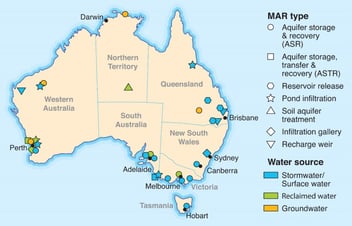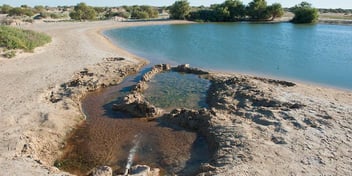Underground future for water storage
In 2014, a team of Spanish researchers conducted a nationwide survey investigating the storage potential of aquifers with nearby water sources.
What they found was startling, former CSIRO research Peter Dillon said.
“16 per cent of Spain’s landmass was suitable for storing water underground, and the volume of the storage that they found was 2.6 times the storage capacity of all existing surface water dams in Spain,” he said.
National Centre for Groundwater Research and Training’s Professor Craig Simmons is leading a push to establish a national program to identify aquifers suitable for storing water as part of a national water-banking scheme.
Australia currently has no national water banking or managed aquifer recharge program, and has done little research into finding suitable aquifers outside of capital cities.
“We really need to advance that work, refine it, and stand back and look at it across the country and see what the options are – an appropriate managed aquifer recharge feasibility assessment targeting areas requiring more water across the continent,” he said.
“The first thing we’ve got to do is get government and politicians and the community actually seeing aquifers as a potential storage option.
“It’s critical, and it’s totally missing at the moment. It’s just all too easy to build another dam without giving due consideration to better alternatives.”
Dillon said small dams feeding large aquifers had the potential to be much more efficient than large dams, doing away with high levels of evaporation from surface storage.
Generally, the technology behind recharging aquifers for water banking is relatively simple: surface infiltration and injection bores.
Surface infiltration methods have been used for 40 years in Queensland’s Burdekin delta but maintenance is essential.
“You’ve got to clean out the silt when it gets caught there. Otherwise the structure becomes ineffective not only because it has lost its storage capacity, but also because its infiltration rate has dropped,” Dillon said.
In terms of costs, surface infiltration has been the cheapest method of recharging aquifers, as it requires little capital investment in infrastructure, and often the water used requires no treatment.
“If you’re using infiltration schemes, it’s about 10 cents per kilolitre to recharge and recover water,” Dillon said.
Recharge schemes that use bores, such as Western Australia’s Groundwater Replenishment Scheme, can be more costly, especially if water treatment is required, but they are often still more cost effective than alternative supplies.
The WA scheme uses a thorough multi-stage treatment process, including reverse osmosis, to purify wastewater before injecting it into aquifers and carrying out sophisticated water quality management, yet Dillon said CSIRO research showed it still had a cost saving of 40% on current seawater desalination operations.
Last month, an international team of researchers released a comprehensive new study mapping global groundwater reserves for the first time.


